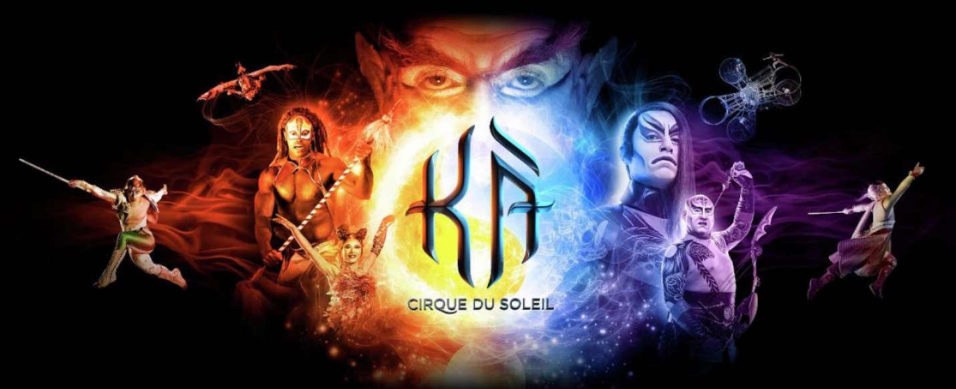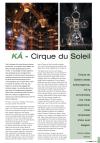The production was designed for the cavernous stage space at the MGM Grand in Las Vegas, after EFX finished its’ run.
It was the first Cirque du Soleil show to feature a narrative storyline.
Dates:
(EFX finished its’ run in January 2003. A 15 month process transformed the venue into what was needed for KA)
Previews: November 26, 2004
Official Opening: February 3, 2005
Statistics
Cost to transform venue: $100 million
Production costs: $65 million
Number of performers: 80
Number of crew:
Costume changes per show: 240
Creative team
Created and Directed by Robert Lepage
Official website: https://www.cirquedusoleil.com/ka
Documents
Trailer
Technology
Sound
The KA auditorium was the first theatre space to have speakers built into every one of the 1950 seats. There are more than 5000 speakers throughout the installation.
Music
The soundtrack for the show is performed live by 8 musicians, who are situated in two soundproof studios backstage.
The largest strung musical instrument in the world is situated in the entrance to the show – the Earth Harp was designed by William Close and is played 15 minutes before the show begins by a performer above the entering audience.
Performance Spaces
There are ten ‘stages’ used by performers, but none of them are visible when the audience enter – they can only see the void – a huge empty space belching fire and smoke.
- Sand Cliff Deck (automated)
- Tatami Deck (automated)
- Downstage Lift
- Stage Left Lift
- Stage Right Lift
- Lift
- Single Lift for Turtle
- Passarelle (fixed walkway 3.5 feet wide at the front of the auditorium, at the edge of the void)
- Auditorium Structures
- Auditorium Aisles
From the former Stage Technologies website:
Location: Las Vegas, USA
Date Commenced: May 2003
Date Completed: October 2004
KÀ™ by Cirque du Soleil® at the MGM hotel in Las Vegas pushes every boundary in theatrical performance and has set a new record for automation technology. KÀ™ has over 200 axes of automation, arguably one of the largest automated productions created, and all controlled by Stage Technologies Nomad control consoles.
Mark Fisher designed the extraordinary sets for this show, creating performance spaces and platforms that rise up from an enormous void (the ‘pit’) where a stage would normally be. There are two main platforms, the ‘tatami deck’ (30ft by 30ft, weighing around 75,000lb) and the ‘sand cliff deck’ (50ft by 25ft, weighing around 80,000lb).
Another remarkable automated effect is used in a scene where five performers transform their tepee tent into a giant, flying bird in order to make their escape. The bird uses five winches to fly out over the auditorium, while the five performers travelling within it flap the wings, creating another crowd-pleasing blend of technology and high-energy performance.
- 5 Nomad control desks
- MaxisID theatre automation control system
- 16 radio-controlled performer flying winches
- 52 BigTow-390 winches
- 5 BigTow-390 winches to fly giant bird
- 26 motors for control of 5 lifts
- Control for 80 cliff deck ‘pegs’
- Control for 3 small pod lifts
- Control for 16 actuators for cliff deck
- 18 hydraulic safety net winches
- Dynamic interlocking system
- Visual Creator software
- Chameleon software
Automated Stage – The Sand Cliff Deck
50 foot x 25 foot ( in metres) 6 foot thick deck, used throughout the show as a ship, a cliff and a sandy beach. It weighs 80,000 pounds and has a 72 feet range of vertical movement. It’s supported and controlled by a customised gantry crane, attached to four 75 foot long hydraulic cylinders (two on each side). The gantry crane weighs 200,000 pounds. The crane assembly had to be lowered into position through the roof of the theatre during construction. For environmental reasons, the hydraulic cylinders use vegetable oil rather than traditional hydraulic fluid. The stage surface is a multi-touch sensor and has three projectors mapped to it, so that whatever orientation the stage is in, the projection stays locked to it. It can rotate 360 degrees at speeds of up to 12 degrees per second, whilst simultaneously tilting up to 100 degrees.
There are three high quality projectors overlapping to create the required brightness. A computer system connects between the touch sensitive stage surface and the projectors to display appropriate images as required by the story.
The deck also includes three elevators built in which are used early in the show, and 80 steel pegs which can be triggered individually, to provide handholds for the acrobats. The pegs are fired out of the deck at a speed of 13 miles per hour.
Automated Stage – The Tatami Deck
30 feet x 30 feet. Was originally to be covered in Tatami mats, but that was changed during the pre-production phase. Weighs 75,000 pounds (34,000 kg). Slides 36 feet forward over the void. Runs on two electric motors and uses a hydraulic braking system.
Airbag
The world’s largest air bag is positioned at the bottom of the void, measuring 65 feet x 46 feet and is 5 feet thick. In addition, acrobatic safety nets are used.
Scenic Elements
As well as the automated decks, the set also contains 14 corrugated steel tubes, which represent trees. These travel across the stage, hung from large tracks.


